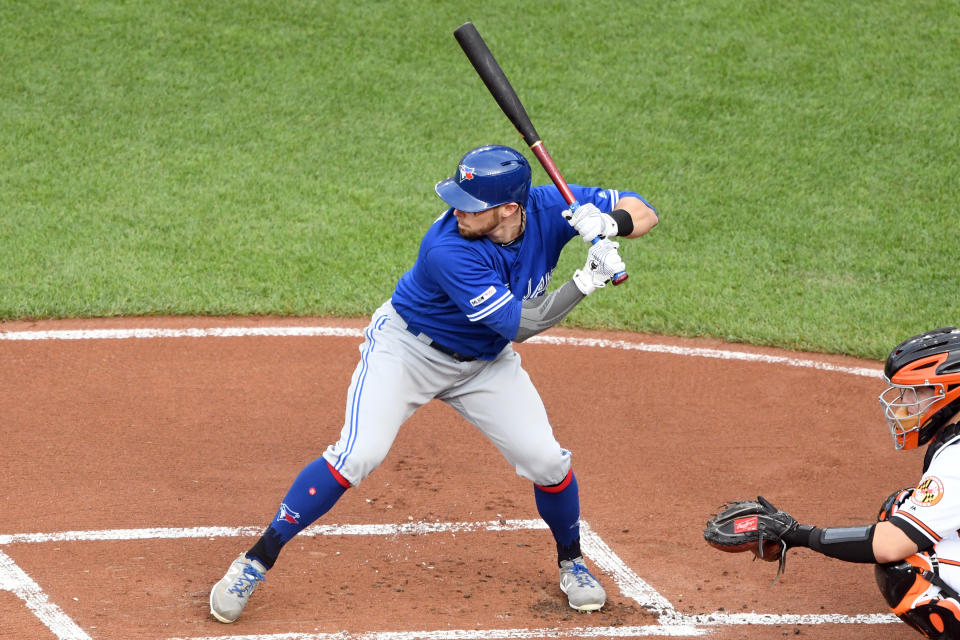The lesson of Eric Sogard

Once upon a time, Eric Sogard was a prospect of sorts. The Padres took him in the second round of the 2007 draft, out of Arizona State; that level of draft capital doesn’t put you on magazine covers, but it reflects potential and investment. Sogard made it to the majors at the front of the decade, started to carve out a pro career.
[Join or create a 2019 Yahoo Fantasy Football league for free today]
Of course, it’s been journeyman status all the way. Sogard’s never been a full-time player for any complete season; his career high in at-bats is a modest 372. He missed one full season with a knee injury. The Brewers released him twice last year; after the second cut, no one came calling. His career OPS+ is a meager 81; that’s an indexed stat where 100 is average. Nothing about his six years in Oakland was particularly memorable, other than those funky glasses.
So why are we writing about Sogard during his age-33 season? Because he’s having an out-of-nowhere career breakthrough, that’s why.
The Blue Jays started to view Sogard as a semi-regular in mid-April, and lately, he’s become a bonafide starter. The production backs it up — he’s slashing .306/.376/.503, with eight homers and six steals. Sogard has led off 10 straight games and 21-of-27, primarily as a second baseman and DH. Over the past 30 days, he’s a Top 20 middle infielder in 5x5 formats.
It’s tricky to reconcile when this type of year comes from thin air. Sogard had 11 career home runs and a .314 slugging percentage before this season. Punch, meet Judy. Sogard has notably raised his launch angle, but he’s not exactly murdering the ball — he’s one of the laggards on the hard-hit leaderboard. Statcast data suggests his batting average should be 42 points lower.

So why should we bother with Sogard at all? Well, he’s doing some things right. The category juice he’s provided through 193 at-bats is useful in all of my mixers. He’s very hard to strike out — his 13.1 percent strikeout rate is in the top nine percent of the league — and he walks regularly. Stolen bases are often about willingness to do it as much as anything else, and being a perfect 6-for-6 reflects proficiency at the task. And lineup space is a currency, too; if the Blue Jays are going to park Sogard in that top spot for a length of time, we should take note of it.
Sogard is owned in a mere 14 percent of Yahoo leagues, as gamers are slow to adopt the story. I can understand this. Many people are going to look at the career path and scoff, too smart and too cool to bother. And others will skip a Sogard type of story because they fear it being a trap, and they don’t want to look stupid in front of their peers.
If you want to be a strong fantasy player, you have to get over these things. You have to be open-minded to what’s possible. You have to accept that real-life value and fantasy value won’t always correlate cleanly. And you have to accept that sometimes players improve their performance, for any number of recognizable or invisible ways.
Is there pumpkin risk with Sogard? Of course. Could he be an obvious cut in a few weeks, off a .175 stretch, stripped of a job? No doubt that’s possible. But the buy-in for this type of player is almost always very low, and if he actually winds up being real, you can make a tidy profit.
If it crashes and burns? Toss to the side, move onto the next episode.
Two months ago, people laughed at Tommy La Stella. Six weeks ago, people were still afraid to cut Joey Votto. NFL players like Arian Foster, Tony Romo, Priest Holmes, and Doug Baldwin were undrafted — and they all turned into stars. Jordan Binnington was an unknown minor-league goalie at the end of 2018; these days, he sips from the Stanley Cup.
I’m not trying to say fantasy owners need to be reckless with decisions. No one’s telling you to cut Jean Segura or Jose Ramirez for Sogard. But appreciate what plausible upside looks like. Keep churning over the bottom of that roster, when it’s reasonable to do so. See what’s possible. Understand the currency of playing time.
If you want to be a winner in a competitive league, you need to think this way. Think like the football coach who wouldn’t dream of punting on fourth-and-short in plus territory, first half. Think like the basketball coach who doesn’t bury a key player just because he’s in early foul trouble. See the game theory here. See the potential here. Heck, accept what’s already happened, even if your opponents won’t.
We’ll worry about August and September, later. Production is where you find it. We don’t have to market our teams, we just want the numbers.
Many of your moves will look bad later, of course. Some will look comically bad. But if you don’t look back on a fantasy baseball season and see a few mistakes made in the interest of being proactive, you’re playing far too conservatively. It’s like in poker, if you’re never caught bluffing, you’re not bluffing enough, ace.
Maybe we’ve talked you into Sogard and maybe we haven’t. Maybe you weren’t with us on La Stella or Lucas Giolito back when those things were gettable. Maybe you’re a wait-for-proof guy, someone who never tries to steal second base. Maybe you’re afraid to take a chance and look bad later.
I’m trying to cure you of that, gamer. I want you to be a better player. Even if you don’t pick up Sogard now, consider the next Sogard story when it comes along.
Follow Scott Pianowski on Twitter

 Yahoo Sports
Yahoo Sports 
